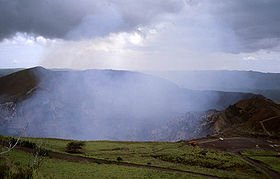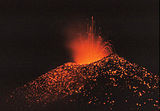- Masaya Volcano
-
Masaya Volcano 
View of the craterElevation 635 m (2,083 ft) [1] Location Location Masaya, Nicaragua Range Central American Volcanic Belt Coordinates 11°58′58″N 86°9′43″W / 11.98278°N 86.16194°WCoordinates: 11°58′58″N 86°9′43″W / 11.98278°N 86.16194°W Geology Type Caldera, Shield volcano Age of rock ~9000 years Volcanic arc/belt Central American Volcanic Belt Last eruption 2008[1] Masaya is a shield volcano located 20 km south of Managua, Nicaragua. It is Nicaragua's first and largest National Park, and one of 78 protected areas of Nicaragua. The volcanic complex is composed of a nested set of calderas and craters, the largest of which is Las Sierras shield volcano and caldera. Within this caldera lies Masaya Volcano sensu stricto, a shallow shield volcano composed of basaltic lavas and tephras. This hosts Masaya caldera, formed 2500 years ago by an 8-km³ basaltic ignimbrite eruption. Inside this caldera a new basaltic complex has grown from eruptions mainly on a semi-circular set of vents that include the Masaya and Nindiri cones. The latter host the pit craters of Masaya, Santiago, Nindiri and San Pedro. Observations in the walls of the pit craters indicate that there have been several episodes of cone and pit crater formation.
The floor of Masaya caldera is mainly covered by poorly vegetated aa lava, indicating resurfacing within the past 1000 or so years, but only two lava flows have erupted since the sixteenth century. The first, in 1670, was an overflow from the Nindiri crater, which at that time hosted a 1-km-wide lava lake. The other, in 1772, issued from a fissure on the flank of the Masaya cone. Since 1772, lava has appeared at the surface only in the Santiago pit crater (presently active and persistently degassing) and possibly within Nindiri crater in 1852. A lake occupies the far eastern end of the caldera.
Masaya continually emits large amounts of sulfur dioxide gas (from the active Santiago crater) and volcanologists study this (amongst other signs) to better understand the behavior of the volcano and also evaluate the impact of acid rain and the potential for health problems.
Although the recent activity of Masaya has largely been dominated by continuous degassing from an occasionally lava-filled pit crater, a number of discrete explosive events have occurred in the last 50 years[1]. One such event occurred on November 22, 1999, which was recognised from satellite data. A hot spot appeared on satellite imagery, and there was a possible explosion. On April 23, 2001 the crater exploded and formed a new vent in the bottom of the crater. The explosion sent rocks with diameters up to 60 cm which travelled up to 500 m from the crater. Vehicles in the visitors area were damaged and one person was injured. On October 4, 2003 an eruption cloud was reported at Masaya. The plume rose to a height of ~4.6 km.
The Masaya Volcano is located in the department of Masaya.
Contents
National park
In 1979, Masaya became Nicaragua's first National Park, named Masaya Volcano National Park (Parque Nacional Volcan Masaya). The National Park has an area of 54 km² includes two volcanoes and five craters,[2] as well as a range of elevations between 100 and 630 meters above sea level. It is the only volcano in the western hemisphere where you are able to drive to the rim. In the park is an underground tunnel which was formed by lava flows, one can find bats and look inside and observe the glowing lava in the dark crater mouth of the volcano.[2]
Geologic setting
Masaya is one of 18 distinct volcanic centers that make up the Nicaraguan portion of the Central American Volcanic Belt (CAVF). Formed by the subduction of the Cocos Plate beneath the Caribbean Plate, along the Mesoamerican trench, the CAVF runs from volcán Tacaná in Guatemala to Irazú in Costa Rica. In western Nicaragua, the CAVF bisects the Nicaraguan Depression from Cosigüina volcano in the northwest to Maderas volcano in Lago Nicaragua. The Interior highlands to the northeast make up the majority of Nicaragua. Western Nicaragua consists of 4 principal geological provinces paralleling the Mesoamerican trench: 1. Pre-Cretaceous to Cretaceous ophiolitic suite; 2. Tertiary basins; 3. Tertiary volcanics; and the 4. Active Quaternary volcanic range.
An ophiolitic suite is found in the Nicoya Complex, which is made up of cherts, graywackes, tholeiitic pillow lavas and basaltic agglomerates. It is intruded by gabbroic, diabasic, and dioritic rocks. The Cretaceous-Tertiary basin is made up of five formations of mainly marine origin. The Rivas and Brito formations are uplifted to the southeast and are overlain in the northwest by a slightly tilted marine near- shore sequence, the El Fraile formation. This in turn passes north into the undeformed Tamarindo formation, a sequence of shallow marine, lacustrine and terrestrial sediments interspersed with ignimbrites. Northeast of the Nicaraguan Depression, the Coyol and Mataglapa formations, run from Honduras to Costa Rica and still show evidence of some volcanic centres, distinguishable as constructional landforms.
Quaternary volcanic rocks are found mainly in the Nicaraguan Depression and form two major groups: the Marrabios and Las Sierras formations. The Marrabios Cordillera starts in the northwest with Cosiguina volcano and continues to the southeast with San Cristobal, Casita, La Pelona, Telica and Rota. El Hoyo, Monte Galan, Momotombo and Momotombito volcanoes are built upon ignimbrite deposits from the nearby Malpaisillo caldera. South-east of Lake Managua lie Chiltepe, the Nejapa alignment, Masaya, Apoyo and Mombacho which overlie the Las Sierras ignimbrites, erupted from the Las Sierras Caldera surrounding Masaya volcano. Further south in Lake Cocibolca (or Lake Nicaragua), Zapatera, Concepcion and Maderas volcanoes mark the end of Nicaraguan section of the CAVF.
Controversy
Local folklore of the Masay Volcano revolve around the belief that the volcano is a gateway to Hell.[2]
See also
References
- ^ a b c "Masaya Volcano". Global Volcanism Program, Smithsonian Institution. http://www.volcano.si.edu/world/volcano.cfm?vnum=1404-10=. Retrieved 2009-01-22.
- ^ a b c "Visiting Masaya Volcano National Park". ViaNica. http://www.vianica.com/activity/2/visiting-masaya-volcano-national-park. Retrieved 2007-08-03.
- Delmelle, P., Stix, J., Baxter, P.J., Garcia-Alvarez, J. and Barquero, J. (2002). Atmospheric dispersion, environmental effects and potential health hazard associated with the low-altitude gas plume of Masaya volcano, Nicaragua. Bulletin of Volcanology, 10.1007/s00445-002-0221-6
- Rymer, H., van Wyk de Vries, B., Stix, J., and Williams-Jones, G. (1998). Pit crater structure and processes governing persistent activity at Masaya Volcano, Nicaragua. Bulletin of Volcanology, 59, 345–355.
- Williams-Jones, G., Rymer, H., and Rothery, D.A. (2003). Gravity changes and passive degassing at the Masaya caldera complex, Nicaragua. Journal of Volcanology and Geothermal Research, 123(1-2), 137–160.
External links
- Dirección General de Geofísica, INETER (in Spanish)
- Volcanoes.ca — Latin American Volcanoes page
- ViaNica.com — Information about visiting the Masaya Volcano National Park
- Masaya Volcano National Park - Tourist Information
Guatemala Acatenango · Agua · Almolonga · Atitlán · Fuego · Jumay · Moyuta · Pacaya · Santa María/Santiaguito · San Pedro · Santo Tomás · Siete Orejas · Tacaná · Tajumulco · Tecuamburro · TolimánEl Salvador Nicaragua Cosigüina · San Cristóbal · Telica · Cerro Negro · Momotombo · Apoyeque · Masaya · Mombacho · Concepción · MaderasCosta Rica Panama Note: volcanoes are ordered from north-west to south-east.Categories:- Active volcanoes
- Protected areas of Nicaragua
- Volcanic calderas
- Volcanoes of Nicaragua
- VEI-6 volcanoes
- Complex volcanoes
- Crater lakes
Wikimedia Foundation. 2010.


